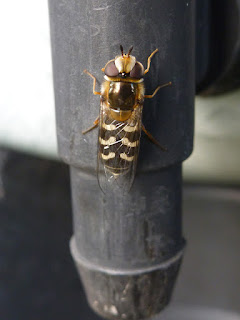Pied Hover-fly Lands
We were pleased to see this insect on our plot last week. There are many different species of hover-fly (around 270 just in Britain) but we identified this one as a female Scaeva Pyrastri, a European species and a common summer migrant to the UK.
Adult hover-flies, also called flower-flies because they feed on the nectar and pollen of flowers, are a welcome visitor to the allotment because their larvae feed on aphids. The larvae differ depending on species, but most are very small, often semi-translucent, pale-green or beige grubs or maggots. Along with ladybirds and lacewings, hover-flies are an important biological pest control against aphids. In Europe, rose bushes are often planted in vineyards to attract hover-flies to lay their eggs amongst the vines.
For the same reason, we grow quite a few flowers and herbs with the express intention of attracting hoverflies to our plot. Amongst their favourites are roses, cosmos, marigolds and the poached egg plant and herbs such as lavender, oregano, dill, fennel, thyme, sweet alyssum, yarrow and garlic chives. As their name suggests, the hover-fly often hovers above the flower whilst collecting nectar.
Scaeva Pyrastri is a large hover-fly, with distinctive creamy-white on black abdomen markings. This accounts for its nickname the 'pied hover-fly'. Most hover-flies are black with yellow or orange banding and look more wasp-like than this one. Others look more like small bees. All hover-flies are harmless however, and their mimicry is to protect them from birds.
Adult hover-flies, also called flower-flies because they feed on the nectar and pollen of flowers, are a welcome visitor to the allotment because their larvae feed on aphids. The larvae differ depending on species, but most are very small, often semi-translucent, pale-green or beige grubs or maggots. Along with ladybirds and lacewings, hover-flies are an important biological pest control against aphids. In Europe, rose bushes are often planted in vineyards to attract hover-flies to lay their eggs amongst the vines.
For the same reason, we grow quite a few flowers and herbs with the express intention of attracting hoverflies to our plot. Amongst their favourites are roses, cosmos, marigolds and the poached egg plant and herbs such as lavender, oregano, dill, fennel, thyme, sweet alyssum, yarrow and garlic chives. As their name suggests, the hover-fly often hovers above the flower whilst collecting nectar.
Scaeva Pyrastri is a large hover-fly, with distinctive creamy-white on black abdomen markings. This accounts for its nickname the 'pied hover-fly'. Most hover-flies are black with yellow or orange banding and look more wasp-like than this one. Others look more like small bees. All hover-flies are harmless however, and their mimicry is to protect them from birds.
Submitted by Jane, plot 9

Comments
Post a Comment